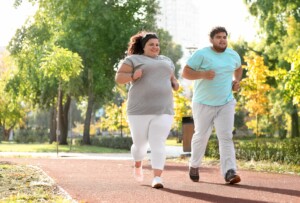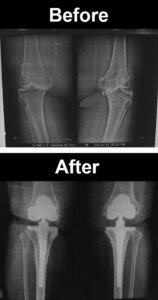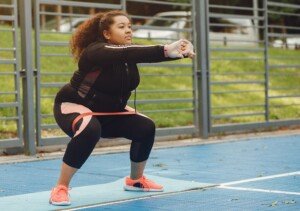Obese and even morbidly obese women may believe exercise will prevent a total knee replacement or other knee problems.
Instagram and YouTube show videos of very heavy women doing any of the following:
• Jogging
• Aggressive dancing
• Jumping up and down
• Squat jumps
• Stationary lunges
• Squats with a very heavy barbell
• Deadlifts with a very heavy barbell
Our knees, says Barbara Bergin, MD, an orthopedic surgeon, never had a chance to evolve into sturdy resilient joints, which is why even among thinner people, knee problems are prevalent.
The knee joint stopped evolving because man invented ways to live with knee pain (crutches, walker, wheelchair, cortisone injections, narcotics, arthroscopy, joint replacement).
These inventions made it very possible for people with injured or worn-down knees to live a long time.
Morbid Obesity Ages the Knee Joint
“When we are morbidly obese, there are tremendous pressures placed on the knee, and morbid obesity ages the knee by 20 years,” says Dr. Bergin, co-founder of Texas Orthopedics, Sports & Rehabilitation Associates.
“This is why we are seeing more and more people in their 40s and 50s with osteoarthritis.
“Additionally, obese people who carry a lot of weight in their thighs cannot walk with their legs in the normal mechanical axis.
“They walk with their legs apart. This puts abnormal stresses on knees, feet and ankles.
“Lastly, if a person already has arthritis, too much weight bearing exercise, squatting and stair climbing can put additional stress on already diseased joints.
“Most of my patients already know this. Their knees hurt when they walk or climb stairs.
“They’ve already quit doing squats because of the pain. But not everyone listens to their bodies.
“Many patients have a high tolerance for pain. Others think that working through pain is beneficial in some way.
“Others are just trying to keep up with family or friends and are embarrassed to discuss their pain. I see these patients all the time.
“Bottom line. We’re trying to keep from having a total knee replacement, and especially from having one when we’re young, because, if they live long enough, it basically commits a person to a revision, which is a salvage operation.
“Knee replacements only last about 20 years, and even less in the younger, heavier patient.
“So taking care of our knees by lowering our weight is of course essential.”
But don’t morbidly obese or obese women who work out have better knees than those who are sedentary?

Shutterstock/New Africa
They do for the moment. For example, the 300 pound woman who can squat 275 pounds (125 kg) has much stronger knees than a similar-weight woman who doesn’t do barbell squats.
But when you see Instagram and YouTube videos of these impressively strong, very large women, you’ll note something very peculiar: They’re all young!
There are middle age women of healthy body weight who can squat and deadlift unbelievable amounts of weight.
However, when today’s “infinifat” or morbidly obese young women are in their 50s, will they even be able to do a bodyweight-only squat without pain?
Will the insane deadlifts only be a distant memory?
Only time will tell, as they continue posting videos on Instagram and YouTube.
Same for the 330 pound influencer who does jump squats and stationary lunges. What will her knees be like at age 55?
Same for the 250 pound women who do trail runs and train for Ironman triathlons.
It’s all very impressive and inspiring NOW. But how long will their knees hold up under all that stress?
Though thin workout enthusiasts often develop “bad” knees, obesity brings an additional risk factor to developing unstable or painful knees. ADDITIONAL.
Dr. Bergin certainly doesn’t believe that very large women should actually avoid exercise.
“But being gentle on our knees in the process is critical as well,” she says.
“An attempt to do exercises which stress our knees, in an attempt to be more healthy, may very well commit us to an unhealthy time for having a total knee replacement.”
What SHOULD obese women do?
Losing weight is a priority, even if she has a massive social media following based on body positivity messages.
The desire to lose weight is NOT fatphobia. It’s knee replacement phobia.

Total knee replacement. Dronainfotech, CreativeCommons
Dr. Bergin explains, “I recommend low impact exercise for overweight and obese patients.
“Swimming, cycling (bicycle or stationary bike), elliptical trainer and walking, as long as these exercises don’t actually cause pain.
“I recommend avoidance of weight training exercises which put increased stresses on the knees: squats, kettlebell squats, jumping jacks, deep knee bends with weights in the hands.
“I recommend that my patients who already have arthritis avoid elective stair climbing and high impact exercise such as running.
“The benefits don’t outweigh the risks. Some patients can do things like partial deep knee bends, partial wall squats, leg presses, leg curls and extensions, without pain. Some patients can row without pain.

Shutterstock/Aleksey Boyko
“But always listen to your body. If it hurts in the joint, it’s probably not best to do it, or at least try to modify the exercise so it no longer hurts.
“There are always patients, trainers and doctors who take offense to my recommendations, or speak out in opposition.
“There are those who say they can do those exercises without pain.
“I base my recommendations on some literature, but also on my extensive, 40-year experience in this field.”
Summary
No matter how strong a very big woman is with a barbell, this will not prevent chronic damage to her knee joint or make her immune to the need for a knee replacement.
Exercise may only delay the onset of pain or osteoarthritis, or, it may hasten it, depending on the exercise.
For example, running, jump squats and deep lunges can “blow out” a knee in an instant.
The best way to reduce the chances of ever developing debilitating knee pain is to get one’s body weight down to a healthy range for one’s height, in addition to listening to one’s body when working out.

Dr. Bergin is a general orthopedist, surgically and conservatively treating all manner of bone and joint conditions. She enjoys educating patients so they can emerge stronger than they were before their orthopedic injury or surgery.
 Lorra Garrick is a former personal trainer certified by the American Council on Exercise. At Bally Total Fitness she trained clients of all ages for fat loss, muscle building, fitness and improved health.
Lorra Garrick is a former personal trainer certified by the American Council on Exercise. At Bally Total Fitness she trained clients of all ages for fat loss, muscle building, fitness and improved health.
.










































